Jump Ahead To:
KAYAK STABILIZER INTRO
Is the term “kayak stabilizer” not familiar to you? Well, it won’t be for long! This is one kayak fishing accessory with tremendous appeal for kayak fishermen of all abilities and experience levels. You have likely seen stabilizers on the water (on a sail boat, for instance) or on land (many times they are installed on cranes).
Stabilizers have been around for hundreds of years. Only recently have they started popping up for kayak fishing, however. KFC has written this Kayak Stabilizer Ultimate Guide to create an all encompassing (and free!) resource for the kayak fishing community so that we can spread the word about all the benefits that kayak stabilizers have to offer! You can also check out our rank of The 5 Best Kayak Outriggers!
KAYAK STABILIZER ULTIMATE GUIDE
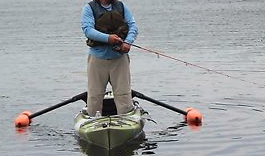
First, as an Amazon Associate, I earn from qualifying purchases.
The KayakFishingCorner.com team has evaluated countless styles of kayak stabilizer. Our Kayak Stabilizer Ultimate Guide contains each of the important details and features that you’ll want to look for when evaluating which kayak stabilizer is right for you. We’ve divided the important details and features into a number of separate categories. We begin with a brief section on kayak stabilizer basics, followed by kayak stabilizer designs, and then go into which kayak stabilizer might be the best fit for you. Towards the end of this Ultimate Guide, we’ve added a link to one of our favorite models of kayak stabilizer, perhaps it would be a good fit for you too! Happy reading!
Overview
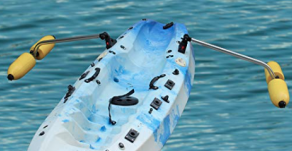
We’ve already used the term many times in this Kayak Stabilizer Ultimate Guide, so let’s be certain that we have a basic understanding of the term “stabilizer” before we get into the meat of this guide. The term “stabilizer” is defined as, “a framework extended outboard from the side of a boat … supporting a float that gives stability” or “a projection with a float … at the end attached to a boat to prevent capsizing”. Kind of technical definitions if you ask me, so we’ve included plenty of pictures to make sure you can see many examples.
We like to add our own definitions sometimes to make sure that they are properly tied to kayak fishing. After all, this is a kayak fishing site! A kayak stabilizer is an after market product intended to be connected to the hull of a fishing kayak for purposes of enhancing the fishing kayak’s ability to balance and to increase stability while increasing surface area, each resulting in a counter balancing effect. Whew! A lot of words, but we think its appropriate!
The typical kayak stabilizer will have one or two arms (very rarely would it have more). Even a one armed stabilizer is going to provide a tremendously increased amount of stability. Why? Well, it will allow a kayak fisherman to smartly position his or her body to distribute weight, thereby serving as a ballast! What is a ballast? Time for the last definition of the guide! A ballast is, “a heavy substance placed in such a way as to improve stability and control”. OK, enough with the definitions!
So, if one kayak stabilizer yields a substantial amount of stability, what would two stabilizers do? Using a dual armed stabilizer provides supreme stability and control. The average length of a kayak stabilizer is about 3 feet long. Upon combining two kayak stabilizers, and then taking into account the width of the pontoons at the end of each stabilizer’s arm (and adding the width of the hull of the fishing kayak itself) the resulting increase in surface area of the kayak will exceed 300%! Yes, the total width has increased to your 9 or 10 feet!
The bigger the width of the fishing kayak, the larger the level of stability and control – its that simple! When properly using a kayak stabilizer, the kayak fisherman will be able to fish from a standing position. No more risk of an overturn! The ability to sit and stand allows the kayak fisherman to “stretch out”, and become more comfortable. This is going to allow the fisherman to stay on the water for longer! The longer you are on the water, the better the odds of you bringing in a greater amount of fish! The more fish, the better the experience!
Keep in mind, particularly if you’re going to be using a fishing kayak with a motor, a little extra balance can help you avoid some pretty precarious situations!
Stabilizer Basics
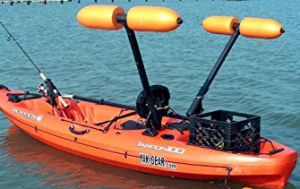
Please note: This post contains affiliate links. An affiliate link means that we may earn advertising/referral fees if you make a purchase through our links.
Shortcut to Kayak Stabilizer Review
Now you’ve read about the basics of the kayak stabilizer, so its time to read about some of the important features to look. After all, if you are deciding which kayak stabilizer you want for your own fishing kayak, you need to know which features are most important!
The connection of the stabilizer to the kayak itself is the most important part of your kayak stabilizer set up. Without a solid point of connection, the stabilizer won’t have a stable base to “push” against. The stable base is critical when boating in fast currents or unforgiving waters! Your stabilizer needs to sit “flush” against the hull of the fishing kayak. You cannot allow any room for rubbing or twisting. If this occurs, it will weaken the connection point and eventually the stabilizer will snap off or tear free from the hull. This could cause significant damage to the kayak.
Also related to the connection point, is the adjustability of the stabilizer’s arms. Adjustability is going to be a function of the connection point. Take a close look at the zoomed in image of the connection point below. Do you see that the device actually features an internal ratcheting system? This ratcheting system is perfect for allowing a number of different angles at which your stabilizer arms can be set.
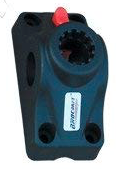
You need the ability to lift or drop the kayak stabilizers based upon the type of water conditions you are experiencing. How does this help? There will be occasions where you’ll need to lower the rudder further into the water. When would you need to do this and why? This would be helpful if you are trying to move forward in a straight line and you’d like to keep a direct course. In order to do this, you’ll lift the stabilizers higher. This will force the rudder, and fishing kayak, to sit more deeply in the water.
Sometimes your waters will be very choppy. During these conditions you want to maximize your stability. You need to avoid an overturn. It is best to lower the stabilizers to put pressure against the water. Lowering your stabilizers will increase your surface area. The increased surface area will help create the counter balancing needed to keep you and your kayak upright! Being properly counter balanced will help your fishing kayak better manage choppy water, straight line winds and quick currents!
Another important part of the kayak stabilizer set up is its pontoons. These are the floats connected to the kayak stabilizer’s arms (we’ve added some photos below). Never heard of the term “pontoon” before? You’ve probably seen them on the water, but let’s add an explanation anyway. A pontoon is, “a float for raising a sunken or deeply laden vessel in the water”. Below is a basic example.
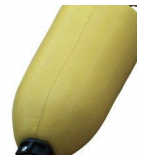
Make sure that your pontoons are big enough buoyancy to push and lift. You’ll need this when encountering big waves and gusting winds. The proper “size” is typically 1 foot in length, and 4 – 6 inches in width, and it is equally important that the kayak stabilizer’s pontoon is made of a high quality material. Only a high quality material will ensure that the pontoon maintains its buoyancy.
KFC typically likes to use molded PVC pontoons. PVC, or polyvinyl chloride, is essentially a highly durable and very buoyant plastic. Most pontoons on the market have the added feature of providing greater visibility! How? The pontoons are frequently brightly colored (see the example of the yellow one from above).
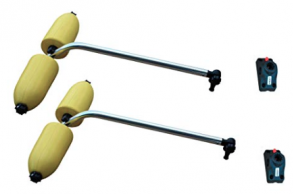
What is another one of the important features to look for in a kayak stabilizer kit? The arms of the kayak stabilizer! The arms of your stabilizer are going to face a lot of pressure as they push against the water. Every time the arms are pushing, they are supporting the weight of, and providing balance to, the fishing kayak.
The average kayak stabilizer is only as good as the length and strength of its arms. Avoid buying a stabilizer kit with short arms? Short arms will not provide you the leverage or surface area. Short arms will not allow you to achieve the counterbalancing you need to control your fishing kayak. It’s also important that the arms not be too long either! If the stabilizer arms are too long, you’ll struggle to navigate the fishing kayak around tight channels. The long arms might also put too much strain on the connection point, putting you at risk for a tear away.
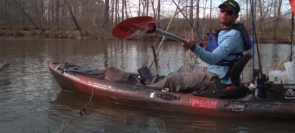
Ensure that the material comprising the arms is high quality. Your stabilizer will be exposed to wet conditions. The stabilizers will also be subject to the strain of an “on again” and “off again” type usage. Also, the fishing kayak will bob up and down with the movement of the water. That’s a lot of movement!
Stabilizer arms built of metal, and even some built of high strength plastic, are most suitable to stand up to the elements and continued movement of the fishing kayak. We like metal arms, but make sure to consider the following. Metal arms are, of course, going to be heavier than plastics. Extra weight isn’t a bad thing when it comes to stabilizer arms. Why? Well, the heavier the arms, the greater the ability of the stabilizer to withstand the punishment of the waves and winds!
Kayak Stabilizer: Buy the Best
(Commissions Earned)
During one of my recent kayak fishing trips, during the late Fall, I departed very early in the morning. I started having success right away!
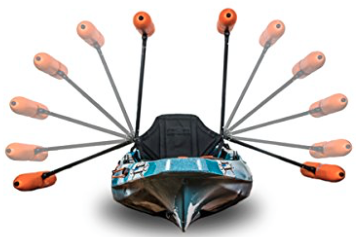
I caught 10 or so large mouth bass in only a few hours. I didn’t notice that a large storm had formed and was headed my way. All of the sudden, the skies grew dark.
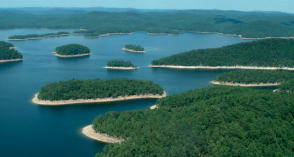
I was stuck in the middle of the lake. The winds went from 5-10mph to 50mph gusts! The high winds and criss crossing wakes from the many power boats racing to get away from the storm nearly caused my fishing kayak to flip over!
I had hundreds of dollars of kayak fishing gear on my fishing kayak! If I had overturned, I would lost all of my gear to the bottom of the lake, never to be seen again. That would have been the end of my season for sure!
Thankfully, I made it back to the dock before I flipped. I promised myself that I would look into all available options to keep my fishing kayak upright. Even in the winds, strong currents, and large and criss crossing wakes! Our KFC contains a number of the kayak stabilizer products that I came across when researching the topic. We hope that one of them could be a great fit for you!
CONCLUSION
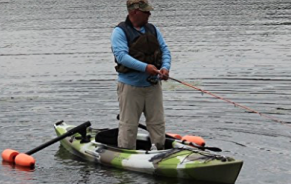
I hope our ultimate guide has helped you learn more about the different types of kayak stabilizer and which features are most important for your own particular style of kayak fishing. Remember, you will not always need kayak stabilizers. Kayak stabilizers are designed to allow you to raise the stabilizers to keep them out of your way when you do not need them. Its actually very easy! But if you find that you do need the stabilizers, just drop the stabilizers into the water and keep on kayak fishing! There are not special tools needs to make this adjustment. Your likelihood of overturning will be vastly reduced!
Also, stabilizers are not “permanent”. This is one of the best things about them. Just snap the stabilizers on and off depending on your needs. You’ll be happy to have this “on again” and “off again” capability!
We are certain that any of the kayak stabilizers showcased above in this Kayak Outrigger Ultimate Guide would be a great fit for you, but we are very fond of the model showcased in the “Our Experience” section of this post! We’d like for you to write in to KFC and share with us which stabilizer you decide upon for your fishing kayak. What do you like about it? What don’t you like about it? Do you have any tips for the rest of this kayak fishing community? If you have any questions about the kayak stabilizer, please post a comment at the bottom of this page, we’d love to chat with you! Learn more about this handy balancing device!
Ok, well where to begin? Take a look at this list of some of awesome kayak fishing destinations in the USA!
Comments
Do you have any questions about which kayak stabilizer might be best for you? Which features are most important? Please share with the rest of the KayakFishingCorner community by posting in the Comments section below.
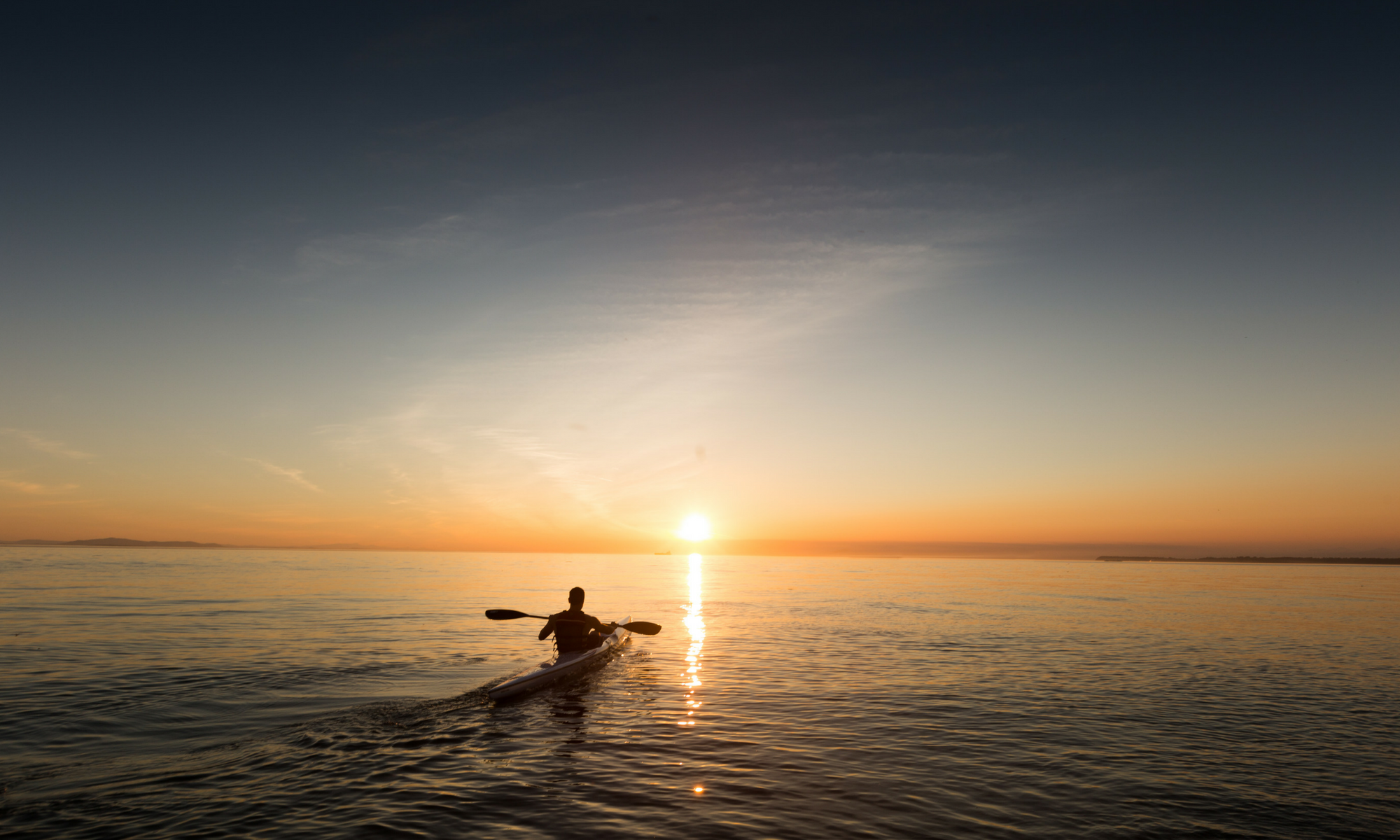
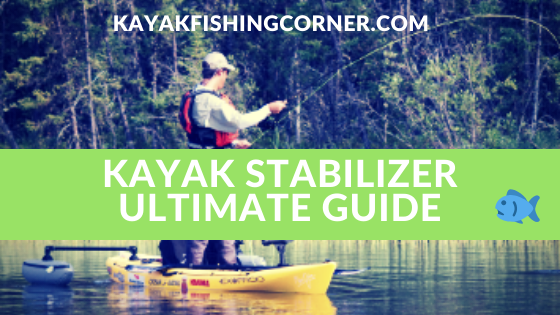

Are Kayak stabilizers designed to work in the ocean?
Hi Jim,
Yes, many are, but be sure to buy the right model. We have a post about what to consider for those of you looking to use kayak stabilizers in the ocean. Check it out here,
David Scott